2021 HYUNDAI SANTA FE CALLIGRAPHY maintenance
[x] Cancel search: maintenancePage 618 of 636
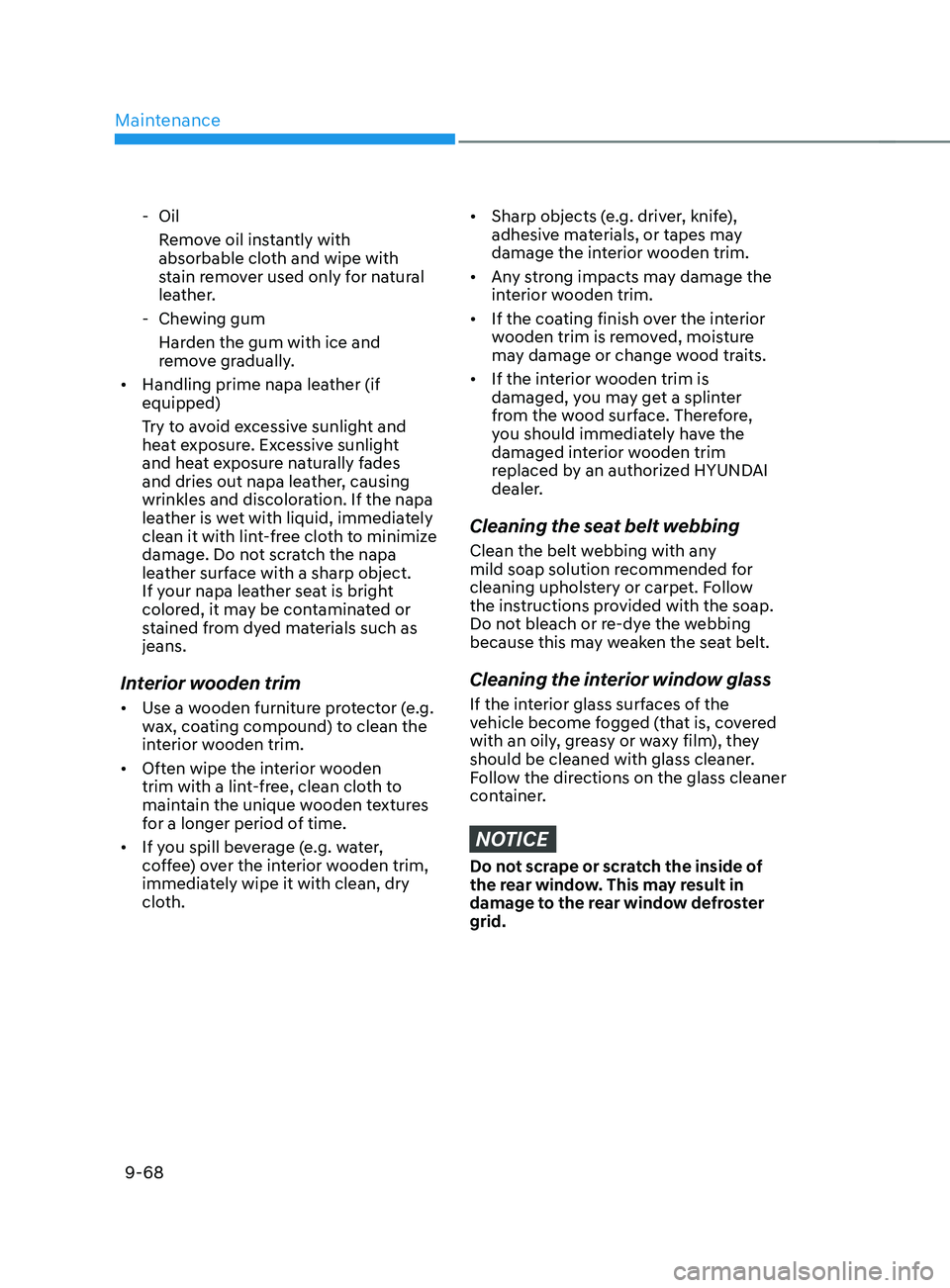
Maintenance
9-68
- OilRemo ve oil instantly with
absorbable cloth and wipe with
stain remover used only for natural
leather.
- Chewing gum
Har
den the gum with ice and
remove gradually.
• Handling prime napa leather (if
equipped)
Try to avoid excessive sunlight and
heat exposure. Excessive sunlight
and heat exposure naturally fades
and dries out napa leather, causing
wrinkles and discoloration. If the napa
leather is wet with liquid, immediately
clean it with lint-free cloth to minimize
damage. Do not scratch the napa
leather surface with a sharp object.
If your napa leather seat is bright
colored, it may be contaminated or
stained from dyed materials such as
jeans.
Interior wooden trim
• Use a wooden furniture protector (e.g.
wax, coating compound) to clean the
interior wooden trim.
• Often wipe the interior wooden
trim with a lint-free, clean cloth to
maintain the unique wooden textures
for a longer period of time.
• If you spill beverage (e.g. water,
coffee) over the interior wooden trim,
immediately wipe it with clean, dry
cloth.
• Sharp objects (e.g. driver, knife),
adhesive materials, or tapes may
damage the interior wooden trim.
• Any strong impacts may damage the
interior wooden trim.
• If the coating finish over the interior
wooden trim is removed, moisture
may damage or change wood traits.
• If the interior wooden trim is
damaged, you may get a splinter
from the wood surface. Therefore,
you should immediately have the
damaged interior wooden trim
replaced by an authorized HYUNDAI
dealer.
Cleaning the seat belt webbing
Clean the belt webbing with any
mild soap solution recommended for
cleaning upholstery or carpet. Follow
the instructions provided with the soap.
Do not bleach or re-dye the webbing
because this may weaken the seat belt.
Cleaning the interior window glass
If the interior glass surfaces of the
vehicle become fogged (that is, covered
with an oily, greasy or waxy film), they
should be cleaned with glass cleaner.
Follow the directions on the glass cleaner
container.
NOTICE
Do not scrape or scratch the inside of
the rear window. This may result in
damage to the rear window defroster
grid.
Page 619 of 636
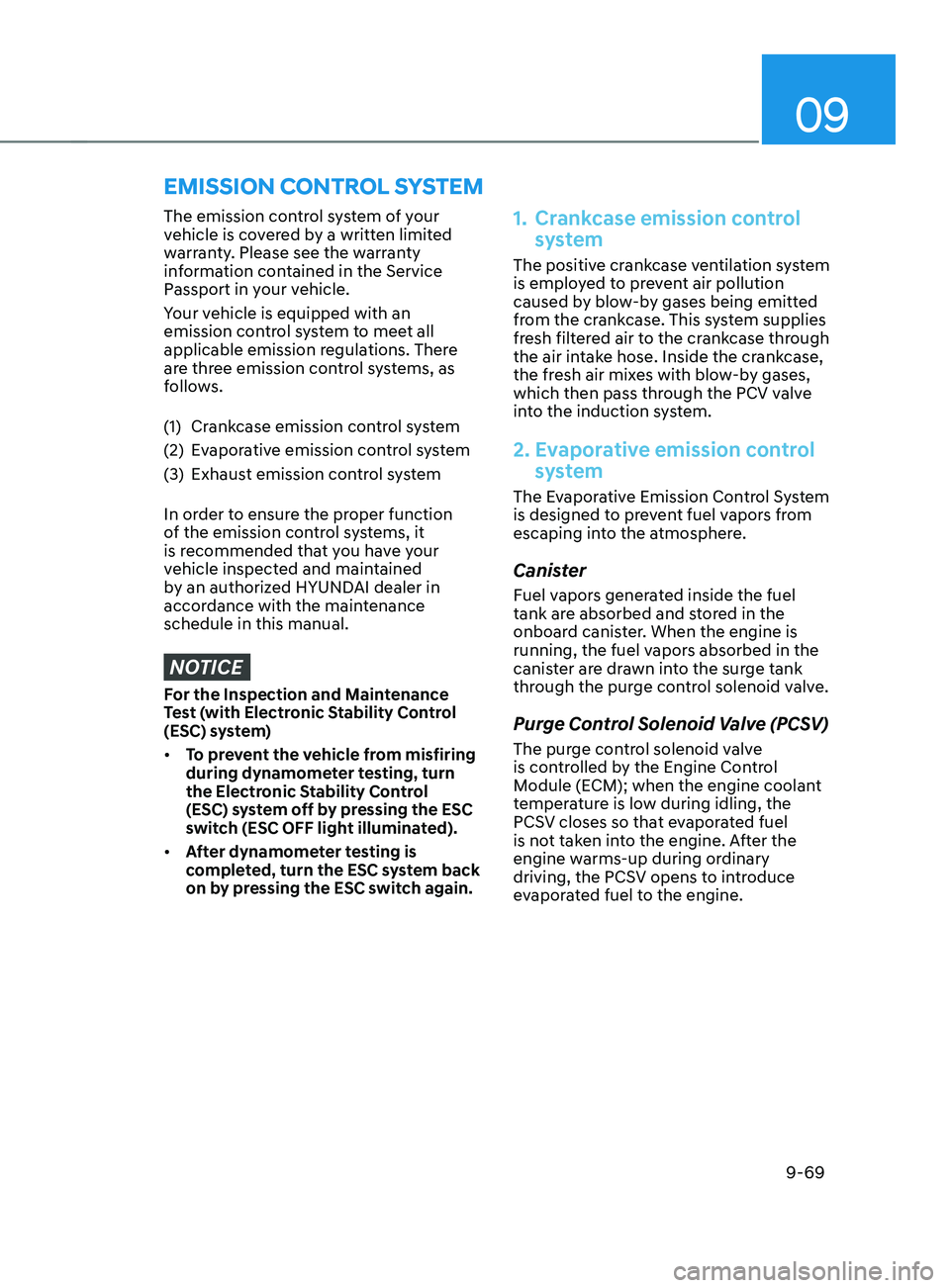
09
9-69
The emission control system of your
vehicle is covered by a written limited
warranty. Please see the warranty
information contained in the Service
Passport in your vehicle.
Your vehicle is equipped with an
emission control system to meet all
applicable emission regulations. There
are three emission control systems, as
follows.
(1)
Crank
case emission control system
(2)
Ev
aporative emission control system
(3)
Exhaust emission con
trol system
In order to ensure the proper function
of the emission control systems, it
is recommended that you have your
vehicle inspected and maintained
by an authorized HYUNDAI dealer in
accordance with the maintenance
schedule in this manual.
NOTICE
For the Inspection and Maintenance
Test (with Electronic Stability Control
(ESC) system)
• To prevent the vehicle from misfiring
during dynamometer testing, turn
the Electronic Stability Control
(ESC) system off by pressing the ESC
switch (ESC OFF light illuminated).
• After dynamometer testing is
completed, turn the ESC system back
on by pressing the ESC switch again.
1. Crankcase emission control
sy
stem
The positive crankcase ventilation system
is employed to prevent air pollution
caused by blow-by gases being emitted
from the crankcase. This system supplies
fresh filtered air to the crankcase through
the air intake hose. Inside the crankcase,
the fresh air mixes with blow-by gases,
which then pass through the PCV valve
into the induction system.
2. Evaporative emission control
system
The Evaporative Emission Control System
is designed to prevent fuel vapors from
escaping into the atmosphere.
Canister
Fuel vapors generated inside the fuel
tank are absorbed and stored in the
onboard canister. When the engine is
running, the fuel vapors absorbed in the
canister are drawn into the surge tank
through the purge control solenoid valve.
Purge Control Solenoid Valve (PCSV)
The purge control solenoid valve
is controlled by the Engine Control
Module (ECM); when the engine coolant
temperature is low during idling, the
PCSV closes so that evaporated fuel
is not taken into the engine. After the
engine warms-up during ordinary
driving, the PCSV opens to introduce
evaporated fuel to the engine.
EMISSION CONTROL SYSTEM
Page 620 of 636
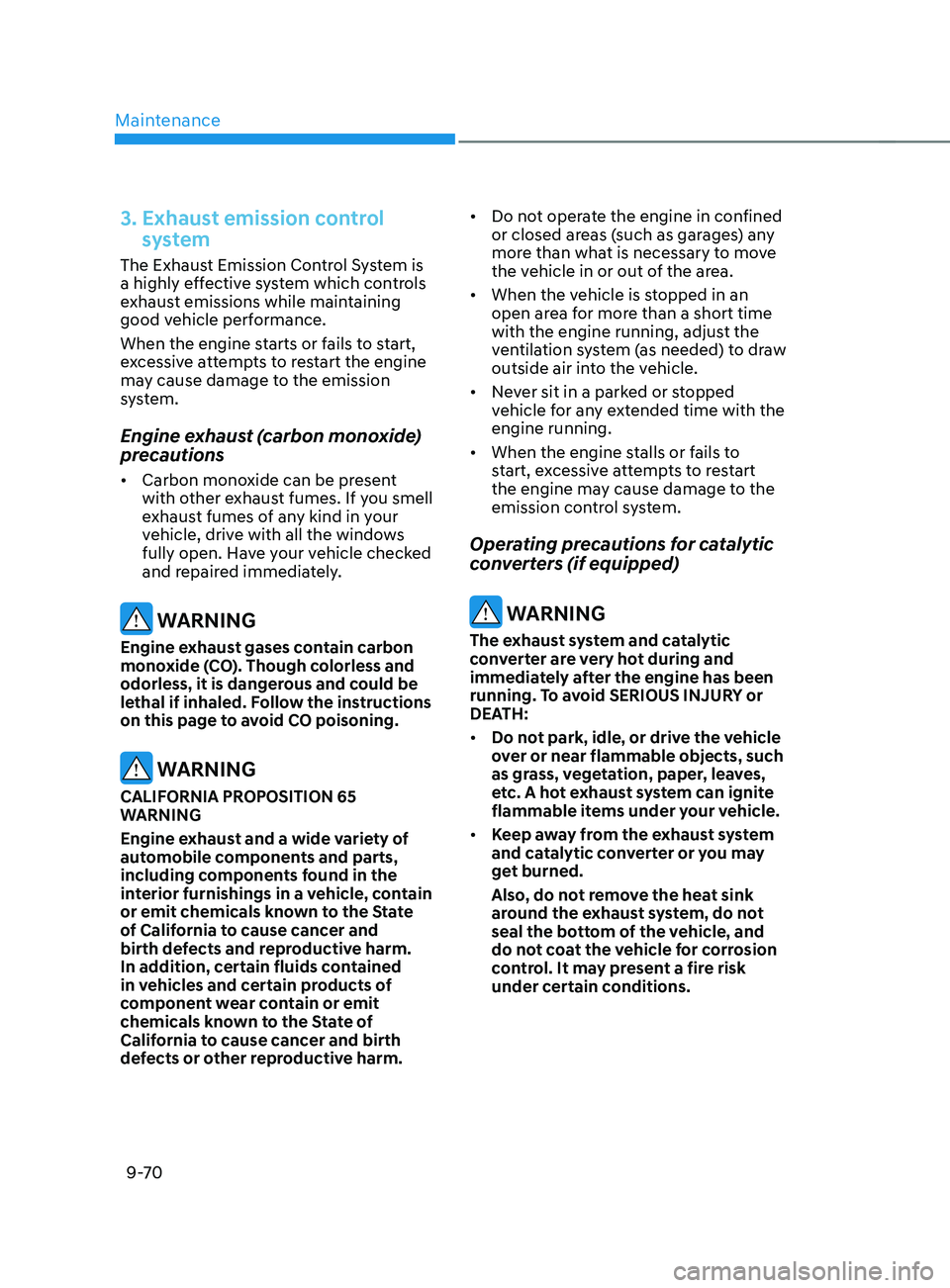
Maintenance
9-70
3. Exhaust emission control
system
The Exhaust Emission Control System is
a highly effective system which controls
exhaust emissions while maintaining
good vehicle performance.
When the engine starts or fails to start,
excessive attempts to restart the engine
may cause damage to the emission
system.
Engine exhaust (carbon monoxide)
precautions
• Carbon monoxide can be present
with other exhaust fumes. If you smell
exhaust fumes of any kind in your
vehicle, drive with all the windows
fully open. Have your vehicle checked
and repaired immediately.
WARNING
Engine exhaust gases contain carbon
monoxide (CO). Though colorless and
odorless, it is dangerous and could be
lethal if inhaled. Follow the instructions
on this page to avoid CO poisoning.
WARNING
CALIFORNIA PROPOSITION 65
WARNING
Engine exhaust and a wide variety of
automobile components and parts,
including components found in the
interior furnishings in a vehicle, contain
or emit chemicals known to the State
of California to cause cancer and
birth defects and reproductive harm.
In addition, certain fluids contained
in vehicles and certain products of
component wear contain or emit
chemicals known to the State of
California to cause cancer and birth
defects or other reproductive harm. •
Do not operate the engine in confined
or closed areas (such as garages) any
more than what is necessary to move
the vehicle in or out of the area.
• When the vehicle is stopped in an
open area for more than a short time
with the engine running, adjust the
ventilation system (as needed) to draw
outside air into the vehicle.
• Never sit in a parked or stopped
vehicle for any extended time with the
engine running.
• When the engine stalls or fails to
start, excessive attempts to restart
the engine may cause damage to the
emission control system.
Operating precautions for catalytic
converters (if equipped)
WARNING
The exhaust system and catalytic
converter are very hot during and
immediately after the engine has been
running. To avoid SERIOUS INJURY or
DEATH:
• Do not park, idle, or drive the vehicle
over or near flammable objects, such
as grass, vegetation, paper, leaves,
etc. A hot exhaust system can ignite
flammable items under your vehicle.
• Keep away from the exhaust system
and catalytic converter or you may
get burned.
Also, do not remove the heat sink
around the exhaust system, do not
seal the bottom of the vehicle, and
do not coat the vehicle for corrosion
control. It may present a fire risk
under certain conditions.
Page 622 of 636
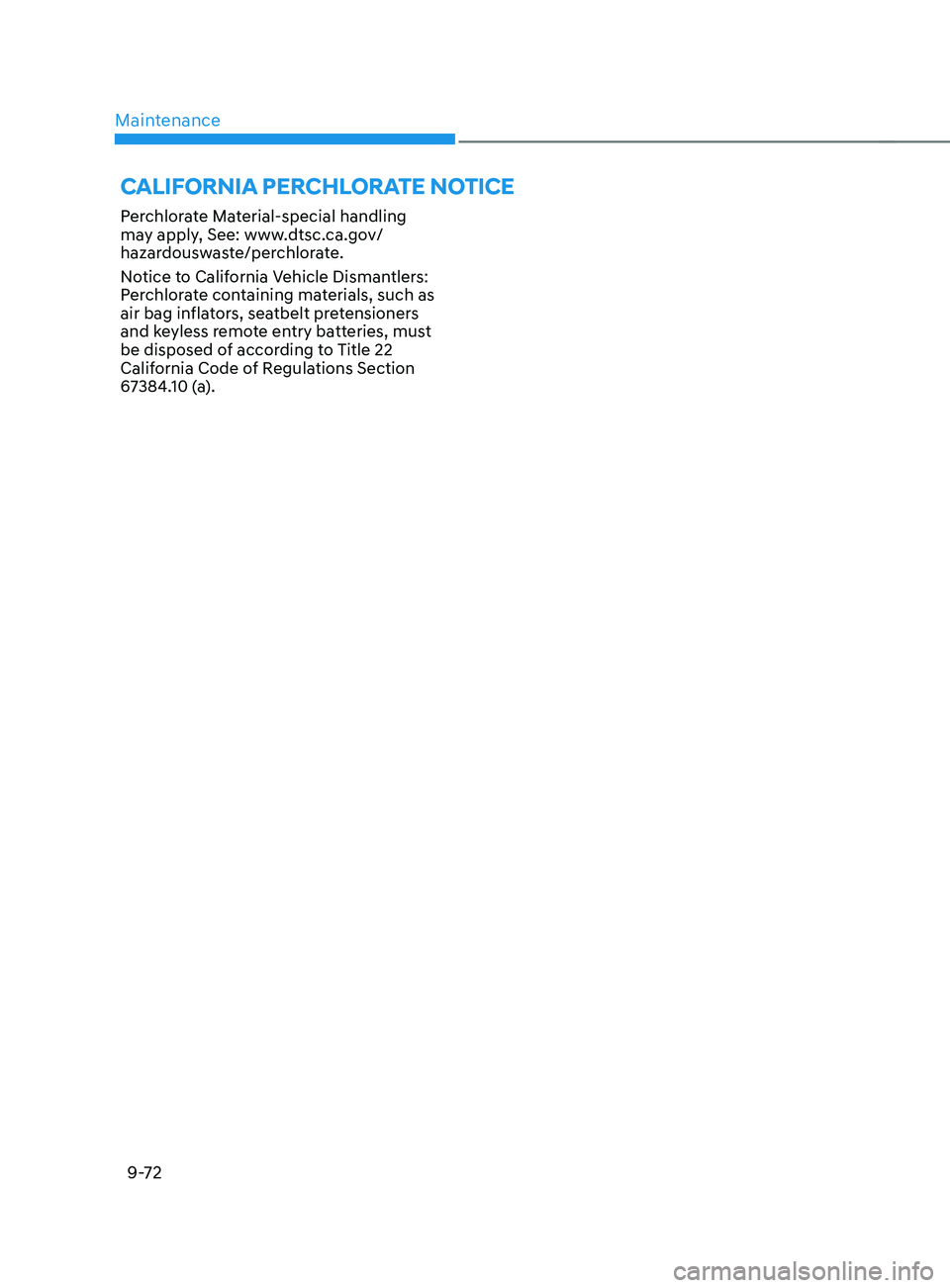
Maintenance9-72
CALIFORNIA PERCHLORATE NOTICE
Perchlorate Material-special handling
may apply, See: www.dtsc.ca.gov/
hazardouswaste/perchlorate.
Notice to California Vehicle Dismantlers:
Perchlorate containing materials, such as
air bag inflators, seatbelt pretensioners
and keyless remote entry batteries, must
be disposed of according to Title 22
California Code of Regulations Section
67384.10 (a).
Page 624 of 636
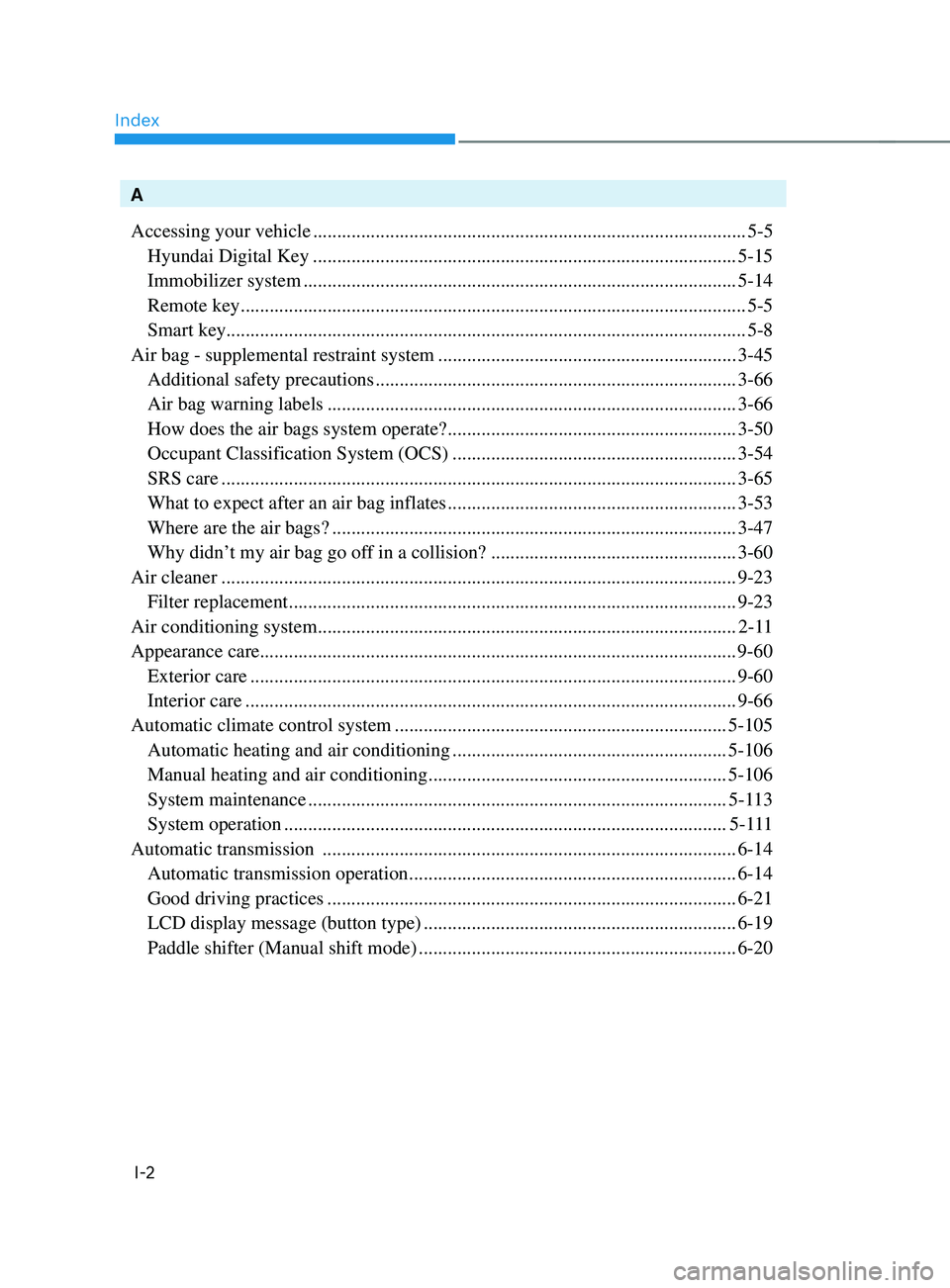
Index
I-2
A
Accessing your vehicle
........................................................................\
..................5-5
Hyundai Digital Key ........................................................................\
................5-15
Immobilizer system ........................................................................\
.................. 5-14
Remote key ........................................................................\
................................. 5-5
Smart key ........................................................................\
.................................... 5-8
Air bag - supplemental restraint system
.............................................................. 3-45
Additional safety precautions ........................................................................\
... 3-66
Air bag warning labels ........................................................................\
............. 3-66
How does the air bags system operate? ............................................................3-50
Occupant Classification System (OCS) ...........................................................3-54
SRS care ........................................................................\
................................... 3-65
What to expect after an air bag inflates ............................................................3-53
Where are the air bags? ........................................................................\
............ 3-47
Why didn’t my air bag go of
f in a collision?
................................................... 3-60
Air cleaner
........................................................................\
................................... 9-23
Filter replacement ........................................................................\
.....................9-23
Air conditioning system
........................................................................\
............... 2-1
1
Appearance care........................................................................\
........................... 9-60
Exterior care ........................................................................\
............................. 9-60
Interior care ........................................................................\
.............................. 9-66
Automatic climate control system
..................................................................... 5-105
Automatic heating and air conditioning .........................................................5-106
Manual heating and air conditioning .............................................................. 5-106
System maintenance ........................................................................\
............... 5-1
13
System operation ........................................................................\
....................5-
111
Automatic transmission
........................................................................\
.............. 6-14
Automatic transmission operation ....................................................................6-14
Good driving practices ........................................................................\
............. 6-21
LCD display message (button type) .................................................................6-19
Paddle shifter (Manual shift mode) .................................................................. 6-20
Page 627 of 636
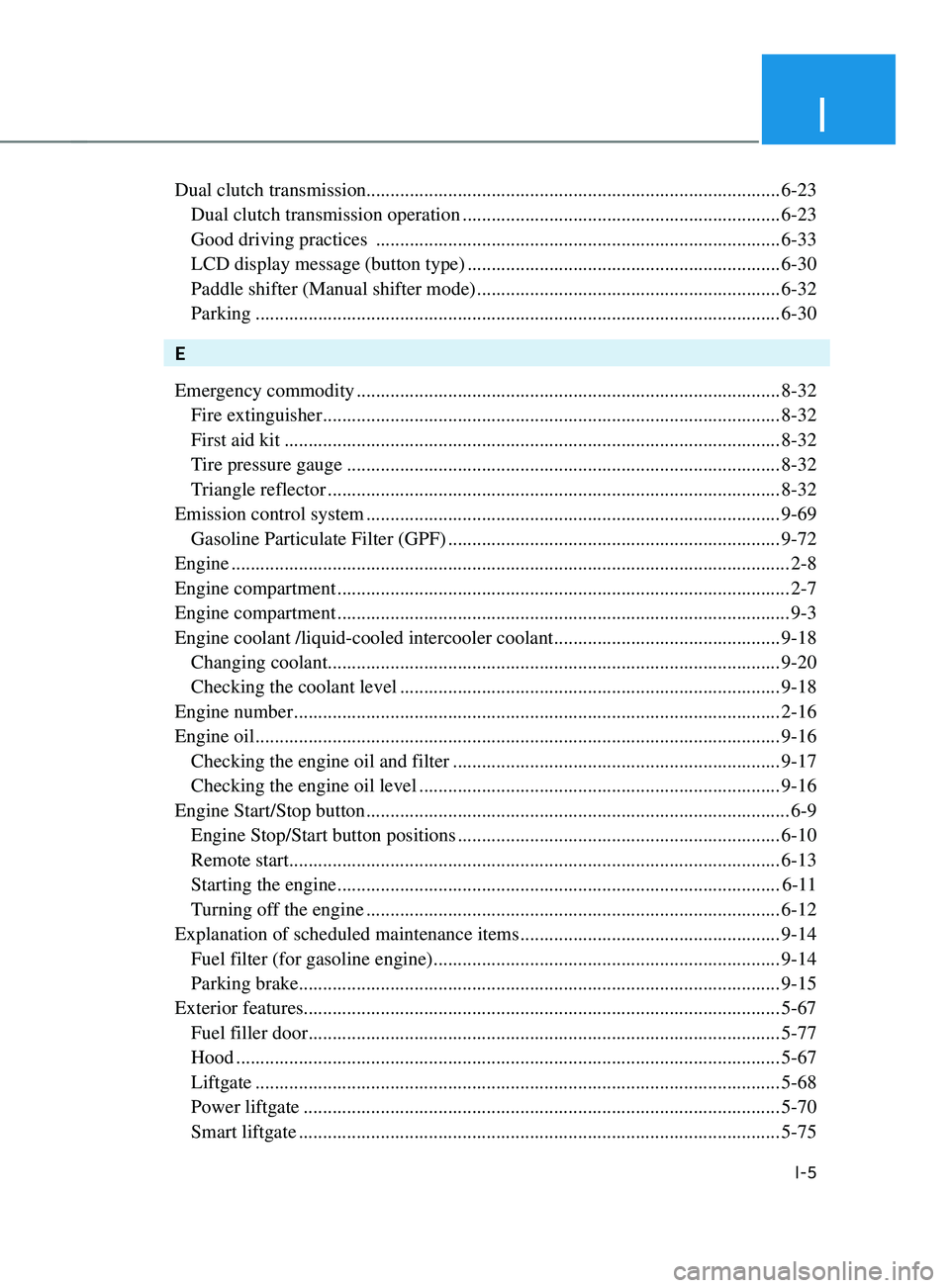
I
I-5
Dual clutch transmission........................................................................\
.............. 6-23
Dual clutch transmission operation ..................................................................6-23
Good driving practices ........................................................................\
............ 6-33
LCD display message (button type) .................................................................6-30
Paddle shifter (Manual shifter mode) ...............................................................6-32
Parking ........................................................................\
..................................... 6-30
E
Emer
gency commodity
........................................................................\
................ 8-32
Fire extinguisher ........................................................................\
....................... 8-32
First aid kit ........................................................................\
............................... 8-32
Tire pressure gauge ........................................................................\
..................8-32
Triangle reflector ........................................................................\
...................... 8-32
Emission control system
........................................................................\
.............. 9-69
Gasoline Particulate Filter (GPF) .....................................................................9-72
Engine
........................................................................\
............................................ 2-8
Engine compartment
........................................................................\
...................... 2-7
Engine compartment
........................................................................\
...................... 9-3
Engine coolant /liquid-cooled intercooler coolant
............................................... 9-18
Changing coolant ........................................................................\
...................... 9-20
Checking the coolant level ........................................................................\
.......9-18
Engine number
........................................................................\
............................. 2-16
Engine oil
........................................................................\
..................................... 9-16
Checking the engine oil and filter ....................................................................9-17
Checking the engine oil level ........................................................................\
... 9-16
Engine Start/Stop button
........................................................................\
................ 6-9
Engine Stop/Start button positions ...................................................................6-10
Remote start ........................................................................\
.............................. 6-13
Starting the engine ........................................................................\
....................6-1
1
Turning of
f the engine
........................................................................\
.............. 6-12
Explanation of scheduled maintenance items
...................................................... 9-14
Fuel filter (for gasoline engine) ........................................................................\
9-14
Parking brake ........................................................................\
............................ 9-15
Exterior features
........................................................................\
........................... 5-67
Fuel filler door ........................................................................\
.......................... 5-77
Hood ........................................................................\
......................................... 5-67
Liftgate ........................................................................\
.....................................5-68
Power liftgate ........................................................................\
...........................5-70
Smart liftgate ........................................................................\
............................ 5-75
Page 632 of 636

Index
I-10
M
Maintenance services
........................................................................\
.....................9-4
Owner maintenance precautions ........................................................................\
9-4
Owner’
s responsibility
........................................................................\
............... 9-4
Manual climate control system
........................................................................\
.... 5-97
Heating and air conditioning ........................................................................\
....5-98
System maintenance ........................................................................\
............... 5-103
System operation ........................................................................\
.................... 5-101
Mirrors
........................................................................\
......................................... 5-45
Inside rearview mirror ........................................................................\
..............5-45
Reverse parking aid ........................................................................\
.................. 5-57
Side View
mirrors
........................................................................\
..................... 5-55
N
Navigation-Based Smart Cruise Control (NSCC)
.............................................. 7-70
Limitations of the system ........................................................................\
......... 7-73
System operation ........................................................................\
...................... 7-71
System settings ........................................................................\
......................... 7-70
O
Owner maintenance
........................................................................\
....................... 9-5
Owner maintenance schedule ........................................................................\
.....9-6
P
Panoramic sunroof
........................................................................\
....................... 5-62
Closing the sunroof ........................................................................\
..................5-64
Resetting the sunroof ........................................................................\
................5-65
Sliding the sunroof ........................................................................\
................... 5-63
Sunroof open warning ........................................................................\
..............5-66
Sunshade
........................................................................\
................................... 5-63
Tilting the sunroof ........................................................................\
.................... 5-64
Page 633 of 636
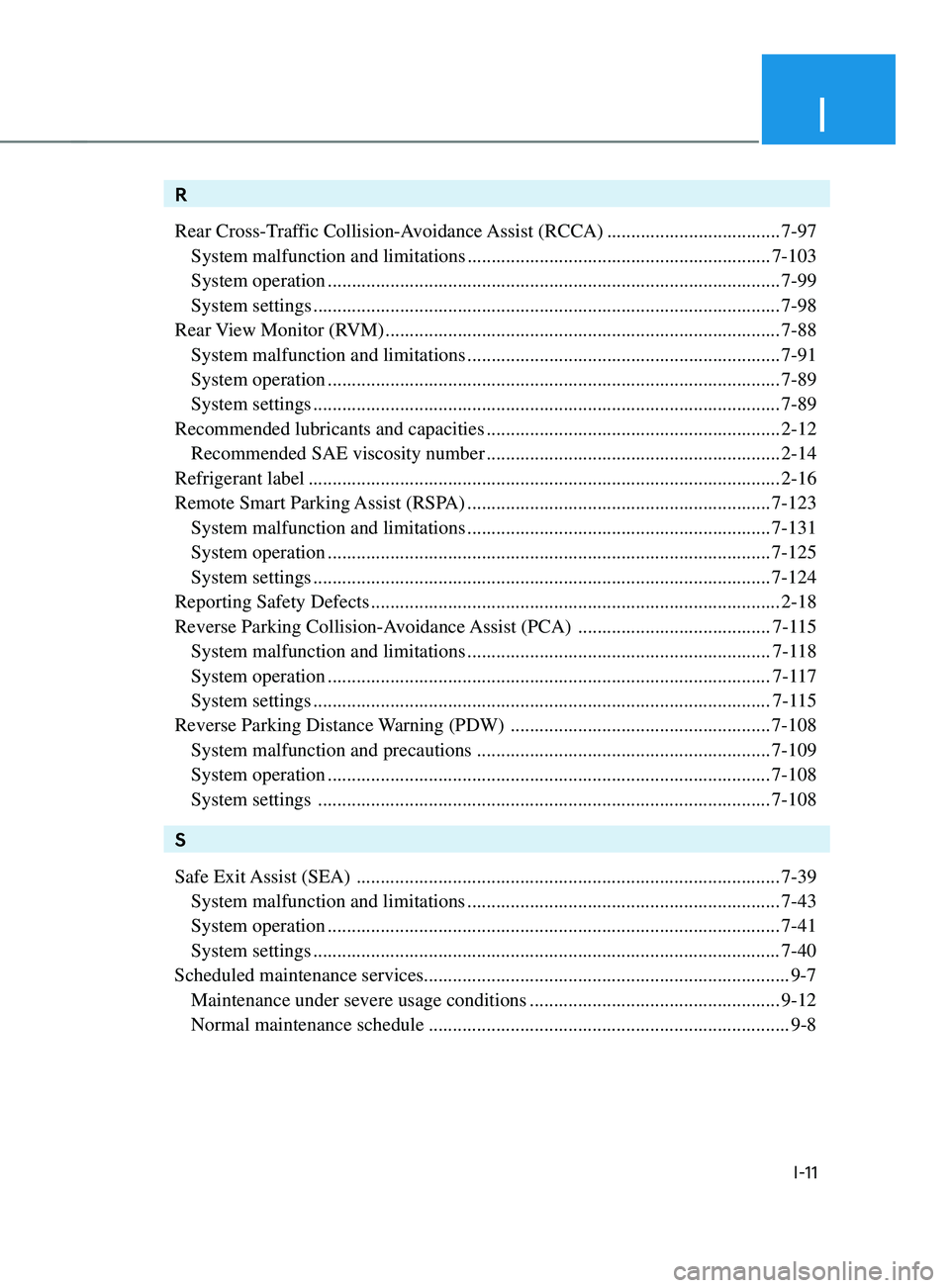
I
I-11
R
Rear Cross-Traffic Collision-Avoidance Assist (RCCA)
....................................7-97
System malfunction and limitations ............................................................... 7-103
System operation ........................................................................\
...................... 7-99
System settings ........................................................................\
......................... 7-98
Rear
View Monitor (RVM)
........................................................................\
.......... 7-88
System malfunction and limitations .................................................................7-91
System operation ........................................................................\
...................... 7-89
System settings ........................................................................\
......................... 7-89
Recommended lubricants and capacities
............................................................. 2-12
Recommended SAE viscosity number .............................................................2-14
Refrigerant label
........................................................................\
.......................... 2-16
Remote Smart Parking
Assist (RSPA)
............................................................... 7-123
System malfunction and limitations ...............................................................7-131
System operation ........................................................................\
.................... 7-125
System settings ........................................................................\
....................... 7-124
Reporting Safety Defects
........................................................................\
............. 2-18
Reverse Parking Collision-A
voidance Assist (PCA)
........................................7-1
15
System malfunction and limitations ...............................................................7-1
18
System operation ........................................................................\
....................7-117
System settings ........................................................................\
....................... 7-1
15
Reverse Parking Distance Warning (PDW)
...................................................... 7-108
System malfunction and precautions ............................................................. 7-109
System operation ........................................................................\
.................... 7-108
System settings ........................................................................\
...................... 7-108
S
Safe Exit
Assist (SEA)
........................................................................\
................ 7-39
System malfunction and limitations .................................................................7-43
System operation ........................................................................\
...................... 7-41
System settings ........................................................................\
......................... 7-40
Scheduled maintenance services
........................................................................\
.... 9-7
Maintenance under severe usage conditions .................................................... 9-12
Normal maintenance schedule ........................................................................\
... 9-8